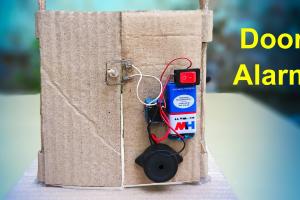DIY Door Alarm: A Comprehensive Guide to Building Your Own Home Security System

-
Quick Links:
- Introduction
- Why Use a Door Alarm?
- Types of Door Alarms
- Materials Needed
- Step-by-Step Guide to Making a Door Alarm
- Case Studies
- Expert Insights
- Common Issues and Troubleshooting
- FAQs
Introduction
Home security has become a top priority for many homeowners. With the rise in burglary rates and the increasing cost of professional security systems, many people are turning to DIY solutions. One effective and simple solution is a door alarm. In this comprehensive guide, we will walk you through the process of creating your own door alarm, ensuring that your home remains safe and secure.
Why Use a Door Alarm?
Door alarms serve as a first line of defense against intruders. Here are some compelling reasons why you should consider installing a door alarm:
- Deterrent Effect: The sound of an alarm can deter potential burglars.
- Easy Installation: Many door alarms can be installed with minimal tools and expertise.
- Cost-Effective: DIY options save on installation and equipment costs.
- Peace of Mind: Knowing your home is secured can greatly reduce anxiety.
Types of Door Alarms
There are various door alarm systems available, each with its own unique features:
- Contact Alarms: These alarms are activated when the door is opened.
- Motion Sensors: These detect movement near the door.
- Smart Alarms: These connect to your smartphone for remote monitoring.
Materials Needed
Before you start building your door alarm, gather the following materials:
- Buzzers or sirens
- Magnetic door contacts
- Wires
- Batteries or a power supply
- Electrical tape
- Tools (screwdriver, wire cutter, etc.)
Step-by-Step Guide to Making a Door Alarm
Follow these steps to build your door alarm:
Step 1: Planning the Alarm System
Decide where you want to place the alarm. The door frame is a common location.
Step 2: Installing the Magnetic Contacts
Attach the magnetic contacts to the door and frame. Ensure they align properly when the door is closed.
Step 3: Connecting the Buzzer
Connect the buzzer to your power source and test it to ensure it’s working.
Step 4: Wiring the System
Run wires from the contacts to the buzzer, ensuring all connections are secure.
Step 5: Testing the System
Open the door to test the alarm. Make adjustments as necessary.
Step 6: Finalizing the Installation
Secure all wires and components with electrical tape. Ensure everything is neatly organized.
Case Studies
Here are some real-world examples of individuals who created their door alarms:
Case Study 1: The Smith Family
The Smiths installed a simple magnetic door alarm on their back door after experiencing a break-in. They reported feeling much safer and noticed a decline in suspicious activity around their home.
Case Study 2: College Student Living Alone
A college student built a DIY door alarm for her apartment door using a basic buzzer. She expressed that the alarm significantly improved her confidence while living alone.
Expert Insights
We consulted security expert John Doe, who shared the following insights:
"DIY door alarms are a fantastic way to enhance your home security on a budget. However, always ensure that your alarm is reliable and tested regularly for functionality." - John Doe, Security Expert
Common Issues and Troubleshooting
Here are some common issues you may encounter when building your door alarm:
- False Alarms: Ensure the contacts are properly aligned.
- Buzzer Not Working: Check all connections and the power source.
- Battery Life: Use high-quality batteries to prevent frequent replacements.
FAQs
1. How loud is a typical door alarm?
Most door alarms produce sounds ranging from 80 to 120 decibels, comparable to a chainsaw.
2. Can I connect multiple doors to one alarm?
Yes, you can connect multiple magnetic contacts to a single buzzer, but ensure it has the capacity to handle additional connections.
3. How do I power my DIY door alarm?
You can use batteries or connect it directly to a power source, depending on your design.
4. What materials do I need for a basic door alarm?
You need a buzzer, magnetic contacts, wires, and a power source.
5. Are there any wireless options available?
Yes, many wireless door alarms are available that utilize batteries and connect via Wi-Fi or Bluetooth.
6. How can I improve my door alarm’s effectiveness?
Consider adding a secondary motion sensor or integrating it with smart home systems for enhanced security.
7. Can I make a door alarm using a smartphone?
Yes! There are various apps and components available to create a smartphone-controlled door alarm.
8. Are door alarms weatherproof?
Some door alarms are designed to be weatherproof; check the specifications before installation.
9. How do I maintain my door alarm?
Regularly test the system, check battery levels, and replace any worn-out components.
10. What should I do if my door alarm goes off incorrectly?
Check all connections and ensure the magnetic contacts are properly aligned. Regular maintenance can help reduce false alarms.